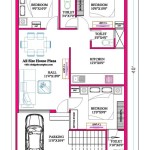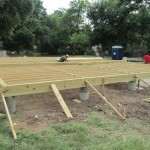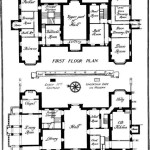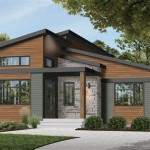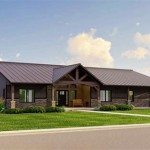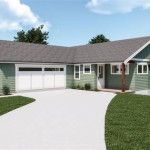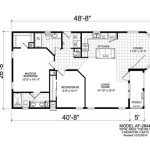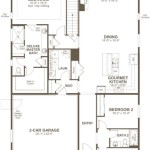Exploring the Advantages and Considerations of One-Floor House Floor Plans
One-floor house floor plans, also known as ranch-style or single-story homes, have consistently maintained popularity among diverse demographics. Their appeal stems from a range of factors, including ease of accessibility, simplified maintenance, and potential cost-effectiveness. This article aims to provide a comprehensive overview of one-floor house floor plans, detailing their benefits, potential drawbacks, design considerations, and suitability for various lifestyles.
Accessibility and Universal Design Principles
Perhaps the most significant advantage of a one-floor house is its accessibility. The absence of stairs makes it ideal for individuals with mobility limitations, including the elderly, those with disabilities, and families with young children. This inherent accessibility aligns with universal design principles, which prioritize creating environments that are usable by all people, to the greatest extent possible, without the need for adaptation or specialized design. Features such as wide doorways, roll-in showers, and lever-handled hardware can be easily incorporated into a one-floor plan to further enhance accessibility and promote independent living.
Furthermore, the absence of stairs reduces the risk of falls, a significant concern for older adults. According to the Centers for Disease Control and Prevention (CDC), falls are a leading cause of injury and death among older Americans. Designing a home without stairs mitigates this risk and promotes a safer living environment for aging in place. Beyond the safety aspects, the convenience of not having to navigate stairs multiple times a day contributes to a more relaxed and comfortable lifestyle for all occupants.
The open floor plan designs commonly associated with single-story homes also contribute to accessibility. These designs often feature fewer walls and wider passageways, allowing for easier maneuverability, especially for individuals using wheelchairs or walkers. This spatial arrangement can also facilitate better communication and interaction among family members, fostering a sense of connection and togetherness.
Cost-Effectiveness and Maintenance Considerations
While the initial construction cost of a one-floor house can sometimes be higher than a multi-story home with the same square footage due to the larger footprint, long-term cost savings can be realized in several areas. Heating and cooling expenses, for instance, tend to be lower in single-story homes. The consistent temperature distribution across a single level eliminates the temperature stratification that often occurs in multi-story houses, where warm air rises to the upper floors and cold air settles on the lower levels.
Maintenance costs are also generally lower for one-floor homes. Exterior maintenance, such as gutter cleaning, window washing, and roof repairs, is significantly easier and often less expensive to perform on a single-story structure. Similarly, interior maintenance tasks, such as painting and cleaning, are simplified by the absence of stairs and multiple levels. This ease of maintenance can be particularly appealing to individuals with busy lifestyles or those who prefer to minimize their home maintenance responsibilities.
Furthermore, insurance premiums may be lower for a one-floor house compared to a multi-story home. Insurance companies often consider single-story homes to be less susceptible to certain types of damage, such as wind damage and water damage from burst pipes, which can be more prevalent in multi-story structures. This potential cost savings can contribute to the overall affordability of owning a one-floor home over the long term.
Design Considerations and Site Suitability
Despite their numerous advantages, one-floor house floor plans also present certain design challenges and considerations. One of the primary challenges is the need for a larger lot size compared to a multi-story home with the same square footage. The footprint of a single-story house is inherently larger, requiring more land to accommodate the structure. This may be a limiting factor in areas with high land costs or where lot sizes are restricted by zoning regulations.
Another design consideration is the potential for less natural light and ventilation in the interior of the home. With all rooms located on a single level, it can be more difficult to strategically position windows and skylights to maximize natural light penetration and airflow. Careful planning and design are essential to ensure that all areas of the house receive adequate natural light and ventilation, creating a bright and comfortable living environment.
Furthermore, the layout of a one-floor house may require more careful consideration to ensure adequate privacy and separation between living areas and bedrooms. Without the vertical separation afforded by multiple floors, it is important to strategically zone the house to create distinct areas for relaxation, entertainment, and sleeping. This can be achieved through the use of hallways, strategically placed walls, and thoughtful furniture arrangements.
Site suitability is also a crucial factor to consider when planning a one-floor house. The topography of the land can significantly impact the feasibility and cost of construction. Building on a sloping lot, for example, may require extensive excavation and grading, which can add to the overall construction costs. In areas prone to flooding, it is essential to elevate the foundation of the house to protect it from water damage. A thorough site analysis should be conducted before finalizing the floor plan to ensure that the design is well-suited to the specific characteristics of the land.
Privacy and Security Considerations
One potential disadvantage of single-story homes often mentioned is perceived lack of privacy and security. Since all windows and doors are at ground level, there may be concerns about easy access for intruders. However, this can be mitigated with thoughtful design and security measures. Strategically placed landscaping, such as dense shrubs and trees, can provide a natural barrier and deter potential intruders. Window coverings, such as blinds or curtains, can also enhance privacy and prevent unwanted views into the home.
Furthermore, modern security systems can provide an added layer of protection. Alarm systems with door and window sensors, motion detectors, and security cameras can deter burglars and provide peace of mind. Smart home technology can also be integrated to allow homeowners to remotely monitor their property and control lighting, locks, and other security features. These security measures can effectively address any perceived vulnerabilities associated with single-story living.
The layout of the floor plan can also impact privacy. Bedrooms should ideally be located away from high-traffic areas and positioned to minimize noise intrusion from the street or neighbors. A well-designed one-floor house can provide a sense of seclusion and tranquility, despite its proximity to the ground level. Careful planning and attention to detail are essential to create a private and secure living environment.
Adapting One-Floor Plans for Different Lifestyles
One-floor house floor plans can be adapted to suit a wide range of lifestyles and family compositions. For young families, the open floor plan designs often associated with single-story homes provide a safe and spacious environment for children to play and explore. The absence of stairs eliminates the risk of falls, and the open layout allows parents to easily supervise their children from multiple areas of the house.
For empty nesters and retirees, a one-floor house offers a comfortable and convenient living space that is easy to maintain and navigate. The absence of stairs eliminates the physical strain of climbing multiple floors, and the simplified layout reduces the burden of cleaning and maintaining a large home. This allows retirees to age in place comfortably and independently, without the need to relocate to a more accessible dwelling.
For individuals who work from home, a one-floor house can provide a dedicated office space that is separate from the main living areas. This separation allows for a more productive and focused work environment, free from distractions. The open floor plan designs can also facilitate collaboration and communication with remote team members, creating a more seamless and efficient work experience.
The versatility of one-floor house floor plans extends beyond specific demographics. They can be easily customized to accommodate a variety of hobbies and interests, such as gardening, woodworking, or art. A dedicated studio or workshop space can be incorporated into the floor plan to provide a space for creative pursuits. Outdoor living areas, such as patios and decks, can also be integrated into the design to create an extension of the indoor living space, perfect for entertaining and relaxation.

Unique One Story House Plans Monster

Small One Story 2 Bedroom Retirement House Plans Houseplans Blog Com
House Plan Of The Week Simple One Story Design Builder

Unique One Story House Plans Monster

One Story House Plan Examples
Must Have One Story Open Floor Plans Blog Eplans Com

Modern Minimalist One Story House Plans With Deck

Modern One Story House Plot 20x17 Meter With 2 Beds Pro Home Decors

Best One Story House Plans And Ranch Style Designs

Small One Story 2 Bedroom Retirement House Plans Houseplans Blog Com

